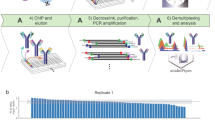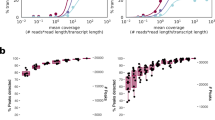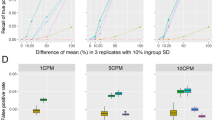Abstract
Model-based analysis of ChIP-seq (MACS) is a computational algorithm that identifies genome-wide locations of transcription/chromatin factor binding or histone modification from ChIP-seq data. MACS consists of four steps: removing redundant reads, adjusting read position, calculating peak enrichment and estimating the empirical false discovery rate (FDR). In this protocol, we provide a detailed demonstration of how to install MACS and how to use it to analyze three common types of ChIP-seq data sets with different characteristics: the sequence-specific transcription factor FoxA1, the histone modification mark H3K4me3 with sharp enrichment and the H3K36me3 mark with broad enrichment. We also explain how to interpret and visualize the results of MACS analyses. The algorithm requires ∼3 GB of RAM and 1.5 h of computing time to analyze a ChIP-seq data set containing 30 million reads, an estimate that increases with sequence coverage. MACS is open source and is available from http://liulab.dfci.harvard.edu/MACS/.
This is a preview of subscription content, access via your institution
Access options
Subscribe to this journal
Receive 12 print issues and online access
$259.00 per year
only $21.58 per issue
Buy this article
- Purchase on Springer Link
- Instant access to full article PDF
Prices may be subject to local taxes which are calculated during checkout





Similar content being viewed by others
References
Mardis, E.R. ChIP-seq: welcome to the new frontier. Nat. Methods 4, 613–614 (2007).
Park, P.J. ChIP-seq: advantages and challenges of a maturing technology. Nat. Rev. Genet. 10, 669–680 (2009).
Barski, A. et al. High-resolution profiling of histone methylations in the human genome. Cell 129, 823–837 (2007).
Johnson, D.S., Mortazavi, A., Myers, R.M. & Wold, B. Genome-wide mapping of in vivo protein-DNA interactions. Science 316, 1497–1502 (2007).
Mikkelsen, T.S. et al. Genome-wide maps of chromatin state in pluripotent and lineage-committed cells. Nature 448, 553–560 (2007).
Robertson, G. et al. Genome-wide profiles of STAT1 DNA association using chromatin immunoprecipitation and massively parallel sequencing. Nat. Methods 4, 651–657 (2007).
Dohm, J.C., Lottaz, C., Borodina, T. & Himmelbauer, H. Substantial biases in ultra-short read data sets from high-throughput DNA sequencing. Nucleic Acids Res. 36, e105 (2008).
Rozowsky, J. et al. PeakSeq enables systematic scoring of ChIP-seq experiments relative to controls. Nat. Biotech. 27, 66–75 (2009).
Vega, V.B., Cheung, E., Palanisamy, N. & Sung, W.-K. Inherent signals in sequencing-based chromatin-immunoprecipitation control libraries. PLoS ONE 4, e5241 (2009).
Liu, E.T., Pott, S. & Huss, M. Q&A: ChIP-seq technologies and the study of gene regulation. BMC Biol. 8, 56 (2010).
Teytelman, L. et al. Impact of chromatin structures on DNA processing for genomic analyses. PLoS ONE 4, e6700 (2009).
Nix, D.A., Courdy, S.J. & Boucher, K.M. Empirical methods for controlling false positives and estimating confidence in ChIP-seq peaks. BMC Bioinformatics 9, 523 (2008).
Zhang, Y. et al. Model-based analysis of ChIP-seq (MACS). Genome Biol. 9, R137–R137 (2008).
Tavares, L. et al. RYBP-PRC1 complexes mediate H2A ubiquitylation at polycomb target sites independently of PRC2 and H3K27me3. Cell 148, 664–678 (2012).
Ulitsky, I., Shkumatava, A., Jan, C.H., Sive, H. & Bartel, D.P. Conserved function of lincRNAs in vertebrate embryonic development despite rapid sequence evolution. Cell 147, 1537–1550 (2011).
He, H.H. et al. Nucleosome dynamics define transcriptional enhancers. Nat. Genet. 42, 343–347 (2010).
Zheng, W., Zhao, H., Mancera, E., Steinmetz, L.M. & Snyder, M. Genetic analysis of variation in transcription factor binding in yeast. Nature 464, 1187–1191 (2010).
Noordermeer, D. et al. The dynamic architecture of Hox gene clusters. Science 334, 222–225 (2011).
Welboren, W.-J. et al. ChIP-seq of ERα and RNA polymerase II defines genes differentially responding to ligands. EMBO J. 28, 1418–1428 (2009).
Birney, E. et al. Identification and analysis of functional elements in 1% of the human genome by the ENCODE pilot project. Nature 447, 799–816 (2007).
Liu, T. et al. Cistrome: an integrative platform for transcriptional regulation studies. Genome Biol. 12, R83 (2011).
Jothi, R., Cuddapah, S., Barski, A., Cui, K. & Zhao, K. Genome-wide identification of in vivo protein–DNA binding sites from ChIP-seq data. Nucleic Acids Res. 36, 5221–5231 (2008).
Ji, H. et al. An integrated software system for analyzing ChIP-chip and ChIP-seq data. Nat. Biotech. 26, 1293–1300 (2008).
Zang, C. et al. A clustering approach for identification of enriched domains from histone modification ChIP-seq data. Bioinformatics 25, 1952–1958 (2009).
Fejes, A.P. et al. FindPeaks 3.1: a tool for identifying areas of enrichment from massively parallel short-read sequencing technology. Bioinformatics 24, 1729–1730 (2008).
Valouev, A. et al. Genome-wide analysis of transcription factor binding sites based on ChIP-seq data. Nat. Methods 5, 829–834 (2008).
Laajala, T.D. et al. A practical comparison of methods for detecting transcription factor binding sites in ChIP-seq experiments. BMC Genomics 10, 618 (2009).
Wilbanks, E.G. & Facciotti, M.T. Evaluation of algorithm performance in ChIP-seq peak detection. PLoS ONE 5, e11471 (2010).
Pepke, S., Wold, B. & Mortazavi, A. Computation for ChIP-seq and RNA-seq studies. Nat. Methods 6, S22–S32 (2009).
Barski, A. & Zhao, K. Genomic location analysis by ChIP-seq. J. Cell Biochem. 107, 11–18 (2009).
Malone, B.M., Tan, F., Bridges, S.M. & Peng, Z. Comparison of four ChIP-seq analytical algorithms using rice endosperm H3K27 trimethylation profiling data. PLoS ONE 6, e25260 (2011).
Chen, Y. et al. Systematic evaluation of factors influencing ChIP-seq fidelity. Nat. Methods 9, 609–614 (2012).
Stitzel, M.L. et al. Global epigenomic analysis of primary human pancreatic islets provides insights into type 2 diabetes susceptibility loci. Cell Metab. 12, 443–455 (2010).
Sati, S. et al. High resolution methylome map of rat indicates role of intragenic DNA methylation in identification of coding region. PLoS ONE 7, e31621 (2012).
Li, N. et al. Whole genome DNA methylation analysis based on high throughput sequencing technology. Methods 52, 203–212 (2010).
Langmead, B., Trapnell, C., Pop, M. & Salzberg, S.L. Ultrafast and memory-efficient alignment of short DNA sequences to the human genome. Genome Biol. 10, R25 (2009).
Li, H. & Durbin, R. Fast and accurate short read alignment with Burrows–Wheeler transform. Bioinformatics 25, 1754–1760 (2009).
Li, H. et al. The sequence alignment/map format and SAMtools. Bioinformatics 25, 2078–2079 (2009).
Salmon-Divon, M., Dvinge, H., Tammoja, K. & Bertone, P. PeakAnalyzer: genome-wide annotation of chromatin binding and modification loci. BMC Bioinformatics 11, 415 (2010).
Robinson, J.T. et al. Integrative genomics viewer. Nat. Biotech. 29, 24–26 (2011).
Kent, W.J. et al. The human genome browser at UCSC. Genome Res. 12, 996–1006 (2002).
Nicol, J.W., Helt, G.A., Blanchard, S.G. Jr ., Raja, A. & Loraine, A.E. The integrated genome browser: free software for distribution and exploration of genome-scale datasets. Bioinformatics 25, 2730–2731 (2009).
Acknowledgements
This project was supported by the National Natural Science Foundation of China (31028011 and 31071114); the National Basic Research Program of China (973 Program: 2010CB944904 and 2011CB965104); US National Institutes of Health grant HG4069; and the Excellent Young Teachers Program of Tongji University (2010KJ041).
Author information
Authors and Affiliations
Contributions
Y.Z., T.L. and X.S.L. developed the original MACS algorithm. T.L. developed the current version of the MACS program. J.F. and B.Q. performed the data analysis. J.F., T.L. and X.S.L. wrote the initial manuscript. All authors contributed to the discussion and writing of the final manuscript.
Corresponding authors
Ethics declarations
Competing interests
The authors declare no competing financial interests.
Rights and permissions
About this article
Cite this article
Feng, J., Liu, T., Qin, B. et al. Identifying ChIP-seq enrichment using MACS. Nat Protoc 7, 1728–1740 (2012). https://doi.org/10.1038/nprot.2012.101
Published:
Issue Date:
DOI: https://doi.org/10.1038/nprot.2012.101
This article is cited by
-
Targeted design of synthetic enhancers for selected tissues in the Drosophila embryo
Nature (2024)
-
Single-cell multi-ome regression models identify functional and disease-associated enhancers and enable chromatin potential analysis
Nature Genetics (2024)
-
Cell-type-specific CAG repeat expansions and toxicity of mutant Huntingtin in human striatum and cerebellum
Nature Genetics (2024)
-
Mitotic bookmarking redundancy by nuclear receptors in pluripotent cells
Nature Structural & Molecular Biology (2024)
-
Tgfbr1 controls developmental plasticity between the hindlimb and external genitalia by remodeling their regulatory landscape
Nature Communications (2024)
Comments
By submitting a comment you agree to abide by our Terms and Community Guidelines. If you find something abusive or that does not comply with our terms or guidelines please flag it as inappropriate.



